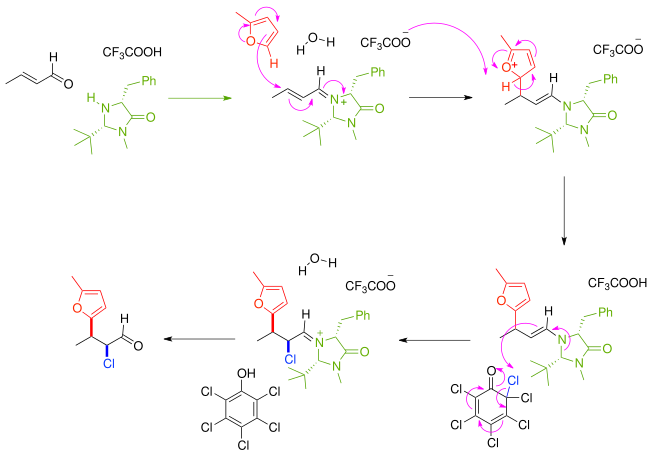|
Nucleophilic conjugate addition
 Nucleophilic conjugate addition is a type of organic reaction. Ordinary nucleophilic additions or 1,2-nucleophilic additions deal mostly with additions to carbonyl compounds. Simple alkene compounds do not show 1,2 reactivity due to lack of polarity, unless the alkene is activated with special substituents. With α,β-unsaturated carbonyl compounds such as cyclohexenone it can be deduced from resonance structures that the β position is an electrophilic site which can react with a nucleophile. The negative charge in these structures is stored as an alkoxide anion. Such a nucleophilic addition is called a nucleophilic conjugate addition or 1,4-nucleophilic addition. The most important active alkenes are the aforementioned conjugated carbonyls and acrylonitriles. Reaction mechanismConjugate addition is the vinylogous counterpart of direct nucleophilic addition. A nucleophile reacts with a α,β-unsaturated carbonyl compound in the β position. The negative charge carried by the nucleophile is now delocalized in the alkoxide anion and the α carbon carbanion by resonance. Protonation leads through keto-enol tautomerism to the saturated carbonyl compound. In vicinal difunctionalization the proton is replaced by another electrophile. Reactions
ScopeConjugate addition is effective in the formation of new carbon-carbon bonds with the help of organometallic reagents such as the organozinc iodide reaction with methylvinylketone.[1] ![(4R',5R')-5-(5-Ethyl-2,2-dimethyl-[1,3]-dioxolan-4-yl)-pentan-2-one](http://upload.wikimedia.org/wikipedia/commons/7/7b/Conjugateadditionexample.png) An example of an asymmetric synthesis by conjugate addition is the synthesis of (R)-3-phenyl-cyclohexanone from cyclohexenone, phenylboronic acid, a rhodium acac catalyst and the chiral ligand BINAP.[2]  In another example of asymmetric synthesis the α,β-unsaturated carbonyl compound first reacts with a chiral imidazolidinone catalyst and chiral auxiliary to an iminium compound in an alkylimino-de-oxo-bisubstitution which then reacts enantioselective with the furan nucleophile. The immediate reaction product is a nucleophilic enamine and the reaction cascades with abstraction of chlorine from a chlorinated quinone. After removal of the amine catalyst the ketone is effectively functionalized with a nucleophile and an electrophile with syn:anti ratio of 8:1 and 97% enantiomeric excess.[3]  This principle is also applied in an enantioselective multicomponent domino conjugated addition of nucleophilic thiols such as benzylmercaptan and electrophilic DEAD.[4]  ToxicologySuitably soluble Michael acceptors are toxic, because they alkylate DNA by conjugate addition. Such modification induces mutations, which are cytotoxic and carcinogenic. However, glutathione is also able to react with them and for example dimethyl fumarate reacts with it. [citation needed] See alsoReferences
|